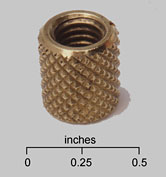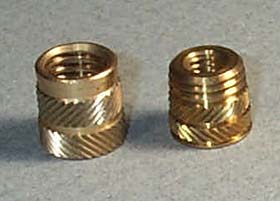Knob Insert
| Application | Garden Equipment |
|---|---|
| Special Features | Savings From Plating; Productivity |
| Part Weight | 0.012 lb. (Brass) |
| Brass Raw Material Premium | 32% (Including Turnings Allowance) |
| Cycle Time (C360 Brass) | 3.75 sec (768 pieces per hour @ 80% Efficiency) |
| Cycle Time (12L14 Steel) | 5.5 sec (458 pieces per hour @ 70% Efficiency) |
| Productivity Gain Using Brass | 68% |
| Net Cost Savings (Brass vs. Plated Steel) * | 12% = $4.60 per 1000 |
| *Zinc/chromate; assumes 0% plating rejects. | |
The Value of High Machinability
 This knob insert combines forming, drilling, tapping and knurling, so it has to be made from a material with very high machinability. Free-Cutting Brass, Copper Alloy 360 (UNS 36000) has the high level of machinability needed to make this product reliably and economically.
This knob insert combines forming, drilling, tapping and knurling, so it has to be made from a material with very high machinability. Free-Cutting Brass, Copper Alloy 360 (UNS 36000) has the high level of machinability needed to make this product reliably and economically.
The insert used to be made from 12L14 leaded steel. With its relatively small size, it was being run at maximum speed on a Davenport. The limiting operation was the internal, bottomed thread: driving and reversing the tap was time-consuming with steel. Changing to Free-Cutting Brass speeded up the tapping operation significantly. In fact, high speed tapping was the main reason for the healthy 32% (1.75 sec.) decrease in cycle time when the insert was switched from steel to Free-Cutting Brass.
Eliminate Plating Costs
Added benefits gained by changing from steel to Free-Cutting Brass included a noticeably finer surface finish (very evident on the threads) and, even more important, eliminating the need for plating. Brass has a natural corrosion resistance so it ordinarily doesnt have to be plated. Plating costs money and it can be a source of rejects. Being able to eliminate zinc/chromate plating on this knob insert saved $1.94 per thousand pieces.
Brass is as Strong as Steel
Many designers don't realize that the strength of half-hard Free-Cutting Brass and cold-reduced 12L14 leaded steel (the most common conditions for screw machine parts) overlap the same range. Here are the published nominal values:
| Material | Tensile Properties | |
|---|---|---|
| Yield Strength | Ultimate Strength | |
| C36000 | 45 ksi | 58 ksi |
| Hot Rolled 12L14 | 34 ksi | 57 ksi |
| Cold Drawn 12L14 | 60 ksi | 78 ksi |
That means that for this knob insert, and for almost one-half of all screw machine products, brass can be substituted for leaded steel without any sacrifice in strength or safety.
Inserts for Molded Plastic
| Application | Automotive Parts |
|---|---|
| Special Features | Internal Threads, Knurling |
| Part Weight | 0.033 lb. (Brass) |
| Brass Raw material Premium | 17% (Including Turnings Allowance) |
| Cycle Time (C360 Brass) | 4.75 sec (606 pieces per hour @ 80% Efficiency) |
| Cycle Time (Leaded Steel) | 8.4 sec (300 pieces per hour @ 70% Efficiency) |
| Productivity Gain Using Brass | 102% |
| Net Cost Savings (Brass vs. Bare Steel) | 23% = $58.76 per 1000 |
| Net Cost Savings (Brass vs. Plated Steel)* | 26% = $71.05 per 1000 |
Productivity and Plating Savings Switch Part from Steel to Brass
 These inserts for molded plastic parts must be strong and corrosion resistant to work in automotive applications; it's a fairly typical screw machine product. The inserts are now made from Free-Cutting Brass, Copper Alloy 360, (UNS C36000); they used to be made from 12L14 leaded steel, but they cost about 26% less in brass than in steel. Many designers think that because brass costs more than steel, machined brass parts must cost more too. That's not true for typical screw machine jobs. Only brass rod's off-the-shelf material cost is significantly higher; these inserts produce more than four times as much turnings weight as they do product and after discounting for the turnings' high value, the net material cost difference is only 17%.
These inserts for molded plastic parts must be strong and corrosion resistant to work in automotive applications; it's a fairly typical screw machine product. The inserts are now made from Free-Cutting Brass, Copper Alloy 360, (UNS C36000); they used to be made from 12L14 leaded steel, but they cost about 26% less in brass than in steel. Many designers think that because brass costs more than steel, machined brass parts must cost more too. That's not true for typical screw machine jobs. Only brass rod's off-the-shelf material cost is significantly higher; these inserts produce more than four times as much turnings weight as they do product and after discounting for the turnings' high value, the net material cost difference is only 17%.
High Machinability Means Lower Production
When you buy machine parts you are paying for machine time. The faster the cut, the lower the cost, and free cutting brass machines faster than leaded steel. The productivity gained by switching from steel to brass for these inserts was a very significant 102%.
Eliminate Plating Costs
Steel rusts, brass tarnishes; an important difference. Exposed steel screw machine parts must be zinc/ chromate plated. Brass parts are ready to use without protective platings. The savings are between 11 and 16 cents per pound of product. If your part has deep holes, threads, or sharp corners, it can be difficult to insure uniform plating on all surfaces. Make the part in brass in you eliminate that concern. The natural corrosion resistance of brass uniformly protects the entire surface. If decorative plating is desired, brass plates more easily and is better looking than plated steel.
Brass is as Strong as Steel
Many designers don't realize that the strength of half-hard Free-Cutting Brass and cold-reduced 12L14 leaded steel (the most common conditions for screw machine parts) overlap the same range. Here are the published nominal values:
| Material | Tensile Properties | |
|---|---|---|
| Yield Strength | Ultimate Strength | |
| C36000 | 45 ksi | 58 ksi |
| Hot Rolled 12L14 | 34 ksi | 57 ksi |
| Cold Drawn 12L14 | 60 ksi | 78 ksi |
That means that for almost one-half of all screw machine products, brass can be substituted for leaded steel without any sacrifice in strength or safety.
